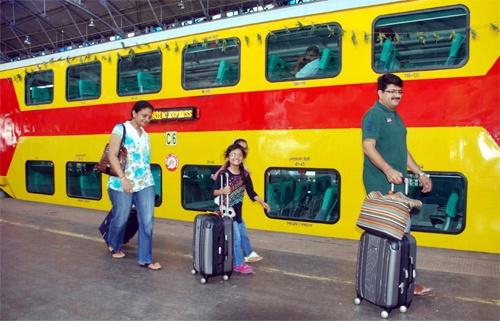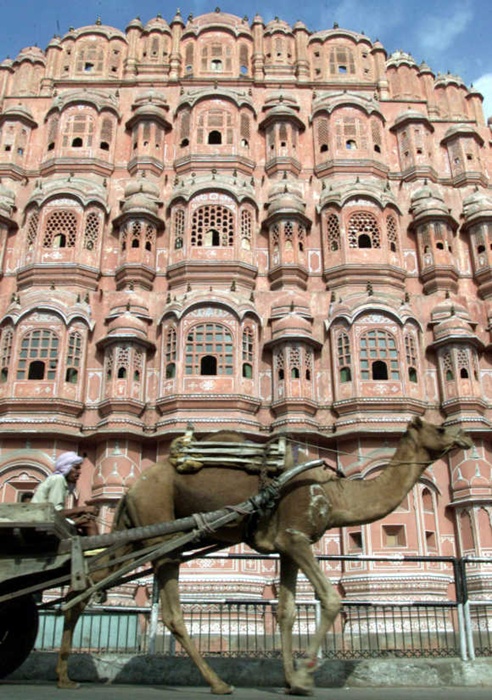Photographs: Sahil Salvi Subir Roy
To be fair to the railways, the compartment is clean, seats comfortable and the train starts on time, says Subir Roy.
The superfast double-decker train running between Delhi and Jaipur is new and posh, says a friend who has just been on it, up and down.
But there is little else about the whole experience, which is either contemporary or bearable, particularly if you are 70 and a heart patient.
It leaves Delhi from Sarai Rohilla, one of the smaller stations being developed by the railways to take the load off New Delhi and Delhi stations.
And Sarai Rohilla remains in the 1950s, be it the approach road, where you get off, or the path you have to trudge to enter the station.
All that belongs to today is that the approach is totally clogged by private cars, many new and flashy. A ditch, a damaged road surface where you can easily trip and stumble, and the dust in the air assail you as you arrive and move forward.
…
A journey in a double-decker train from Delhi to Jaipur
Photographs: Courtesy, RCF Kapurthala
And forget about a safe walk on a smooth surface once you are in the station proper. The cemented flooring must be two decades old.
Try complaining and the inevitable reply is: Chhota station hai na (this is a small station, after all). There is nothing quaint or uncrowded about this small station, though. It has the worst of both worlds, small and big.
The first ordeal is trying to find out from which platform the train leaves. Forget signage; there is absolutely no one to guide you, not even a knowledgeable porter. Ultimately, it is the tea stall vendor who doubles as information counter.
Then, once he has given you the bad news that it is going to be platform two, begins a life-threatening climb up an overbridge (remember, 70 and heart condition) that must be at least three storeys high with a piece of baggage weighing 5 kg to take in essential winter wear.
…
A journey in a double-decker train from Delhi to Jaipur
Photographs: Courtesy, RCF Kapurthala
There may be a recession on and the rural employment guarantee programme may be working way below par, but there seem to be no takers for the job of a railway porter.
Plus, there is little relief in finally reaching platform two; the few benches are either broken or dirty and the equally dirty platform is shared in communal living between man (passengers), animal (stray dogs) and commerce (stalls frying and selling hot bread pakoras in the winter cold).
Getting into the train compartment at last is sheer bliss. To be fair to the railways, the compartment is clean, seats comfortable and the train starts on time.
The view from the upper deck is great — but, while taking it in, be sure not to look at the garbage pile that continues for kilometre after kilometre (high time the Guinness World Records started a category for the longest garbage dump in the world or that great Indian institution — open defecation).
…
A journey in a double-decker train from Delhi to Jaipur
Image: JaipurPhotographs: Reuters
And just when you thought that by not looking out too much and keeping your senses confined inside the compartment you could wish away the Third World, an endless procession starts up and down the aisle of vendors, loudly hawking tomato soup, coffee, cutlets, omelettes or plain sandwiches.
Say goodbye to dozing off after the exertion of climbing the overbridge; best to plug in your earphones and take in a bit of music to soothe your frayed nerves.
As the Pink City gets nearer, you start conjuring up the picture-postcard images from Incredible India showcased to lure tourists, telling yourself you will be able to forget Unbearable Delhi at least for a couple of days.
But at least 15 to 20 minutes before Gandhi Nagar station (Jaipur’s equivalent of Sarai Rohilla) approaches, a queue of passengers – baggage in tow – forms in the aisle, ready to shove and push out of the compartment as soon as the train makes its mandated two-minute stop. Want to try taking it easy, and not get in the middle of the rush? Be prepared to get left behind.
…
A journey in a double-decker train from Delhi to Jaipur
Image: Jaipur Railway StationPhotographs: Arjuncm3/Wikimedia Commons
Then at chhota station Gandhi Nagar, it is a repeat of Sarai Rohilla in more ways than one — the same absence of porters, the trudge up a three-storey-high overbridge, luggage in hand and to hell with the palpitating heart.
The journey back to Delhi is a repeat of the earlier journey. The addition: trying to find some kind of transport outside Sarai Rohilla station to take you home.
The moment the scooter-wallahs hear Punjabi Bagh, they say Rs 300 — and if you ask why, since it is only 6 km, you hear the loud aside: Babu paidal free mein jana chahata hai (Babu wants to go free by foot).
Then if you engage in repartee, interspersing you words with bits of mild Punjabi expletives, they start bargaining and eventually settle for Rs 200.
If you are culturally OK with a good part of Eternal India, then it is fine — so long as you are not too old and not too unfit.







article